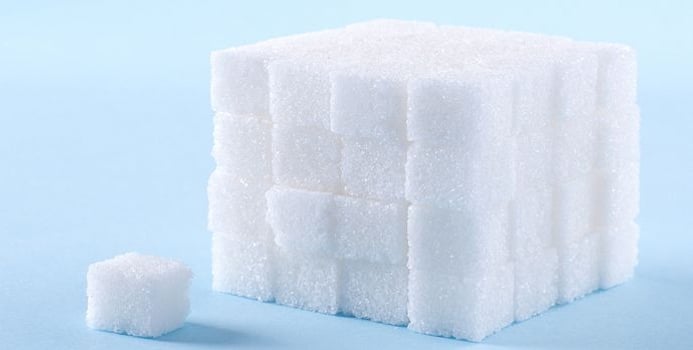The average American consumes 3-6 times more added sugar than the max that leading nutrition experts recommend. In fact, you are likely consuming more sugar than you even realize because of how ubiquitous it is in our food supply. Even if you pass on dessert and think you’re keeping your sugar intake down, you’re probably still taking in too much of the sweet stuff. Surprisingly, sugar is often added to foods that do not really taste sweet, such as salad dressings, condiments, breads, crackers, sauces, and frozen fare. Case in point: one tablespoon of ketchup contains a teaspoon of sugar!
A whopping 74 percent of packaged foods in the U.S. have added sugar. Having too much sugar in your diet can not only lead to weight gain because of the additional empty calories, it significantly boosts your risk of developing type 2 diabetes, cardiovascular disease, and dental cavities. Data has consistently shown that it is nearly impossible to meet your nutrient needs without going over on calories if more than 10 percent of the total calories you eat in a day come from added sugar.
What To Do ...
Scour Food Labels
If you aren’t already doing so, check out the food labels to see how much sugar is in the item you are selecting. Compare similar products to determine which brand or type contains the least amount of sugar. The Food and Drug Administration (FDA) currently requires that food manufacturers list only the total grams of sugar in a product, but soon they will be required to also list “Added Sugars” which the FDA defines as, “sugars that have been added during the processing or packaging of a food.”
What’s in a Name?
You can find 61 different names for added sugar on food labels. There are many different forms of sugar and most often they’re not listed as “sugar” on the ingredient list. If you see any of these words, they are code for sugar: honey, maple syrup, brown rice syrup, high fructose corn syrup, sucrose, dextrose, maltose, evaporated cane juice, fruit juice concentrate, and many others.
Replace Sweets with Fruit
Fruit is like nature’s candy, and it can satisfy your sweet tooth without unraveling your healthy eating plan. Although fruit does contain some natural sugars, it’s also loaded with beneficial nutrients such as fiber, vitamins, minerals, phytochemicals, and antioxidants.
Cut Portion Size
Eliminating sweets completely is not only difficult, it’s unrealistic. Rather than swearing off sugar forever, aim to indulge in sweets occasionally and only in small portions. Indulging in small amounts of your favorite sweets can keep you from feeling deprived, and feeling deprived can lead to you obsessing over a certain “off-limits” food and then overindulging in them. If you’re a fan of chocolate, try having a square of dark chocolate rather than milk chocolate. Dark chocolate has a more intense flavor so you’ll end up satisfied with a smaller portion. Also, pair small amount of sweets with non-sugary items. One of my favorite treats is a handful of cocoa nibs and pistachios. Yum!
Avoid Sugary Beverages
The sugar you consume in liquid form (think soda, frozen sweetened coffee drinks, sports beverages, juice, energy drinks, etc.) is the largest contributor of added sugar in the U.S. diet. Research confirms that your body processes sugars in liquids differently than sugars in solid foods, especially solid foods that contain fiber. You don’t feel as full from liquid calories than from calories in solids. Some lower-sugar beverage options include water, unsweetened tea, plain milk, and coffee. Try putting some fresh or frozen fruit slices in your water for a hint of flavor without much sugar, or add a little unsweetened cocoa powder to your cup of joe for more flavor.
Be Wary of “Low-Fat” Foods
When manufacturers remove some of the fat from foods, they usually replace the fat with added sugar to improve palatability. Fat is not evil — in fact, we need some fat in our diet for normal bodily functions. Beware that being labeled low-fat or fat-free does not mean it’s always a healthy choice.
Spice Up Your Life
Rather than buying flavored oatmeal packs or overloading your latte with sugar, add in a sprinkle of sweet spices such as cinnamon, nutmeg, ginger, or cloves. Vanilla extract and unsweetened cocoa powder can also add a burst of flavor without any sugar.
[Image via Shutterstock]



